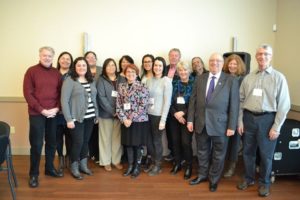Special partnership to help children and youth in Aamjiwnaang First Nation

By Colin Graf
AAMJIWNAANG FIRST NATION—Children and youth with special needs are getting extra help close to home thanks to a special partnership with a local children’s treatment centre.
Speech therapy, physiotherapy, and occupational therapy services will be provided for the first time in homes and at the daycare centre in Aamjiwnaang First Nation, avoiding a long trip for families to the opposite side of the city.
The visiting therapists from the Pathways Health Centre for Children have been well-received in the community since the service began last Nov., says Aamjiwnaang Director of Health Services Sara Plain, and demand is growing.
The services started when Pathways staff approached the First Nation because they realized “the need [for children’s services on local First Nations] was probably greater than the access”, Plain remembers.
While the Centre has worked with First Nations’ families before, helping the children was “not always comfortable, manageable, or doable,” according to Alison Morrison, Pathways’ manager of Clinical Services.
One of the Centre’s volunteers had retired from Sarnia’s Chemical Valley and offered to use his contacts to approach industries to see if they would help fund the services, according to Morrison. Funding came from five different companies; Suncor, Nova Chemicals, Shell, Esso, and Arlanxeo.
The new services are also being offered at two other nearby First Nations, the Chippewas of Kettle & Stony Point and Bkejwanong (Walpole Island). Since the start, services have been increased due to extra money from the federal Jordan’s Principle fund, says Plain.
The help is being welcomed in Aamjiwnaang largely because the two sides have “created a better partnership” by working in new ways to break down barriers that sometimes keep First Nations from accessing needed help, says Plain. While transportation is one barrier, “the fear of going to an unknown location, with unknown people,” whether near or far, is something that often creates reluctance, she explains.
Pathways staff were “willing to go outside of their normal practices” to spend time visiting socially with parents of young children at meetings such as the Aamjiwnaang Healthy Babies program, says Plain. “They’ve been ready to work with us to do whatever is going to meet the community need”, she adds.
“Just becoming familiar to families in the community, which is helping them to build trust,” has helped promote the services, says Morrison. Having already met the therapist helps families feel more comfortable when she or he comes to assess a child for help, she says.
“We’re really happy to be partnering in a different way. We’re looking for opportunities, not coming in with approaches we have used in other places,” Morrison explains. “We’ve said, ‘Let’s take the time and do that right and build together’ ”. “It’s just a matter of thinking about things a little differently,” she says.
The funding has also allowed Aamjiwnaang to hire a child support worker, Rachel Simon, who has been “one of the real strengths” in the new program, says Morrison. Simon has been able to go with parents and children to appointments to help them be comfortable. “That community connection is a really healthy part of this,” Morrison believes.
Initially, the program started off slowly, unsurprisingly, says Simon, but since parents have got to know the therapists, things “have taken off”. Now, the therapists “are booked from the moment they arrive to the moment they leave,” she says.
One of the keys to success is local control, according to Simon.
“We told them we were interested as long as our First Nation was in charge of the services….how they would run, if we could manage it the way we would benefit from it,” she explains.
Pathways has been ready to implement the program the way that the community thinks best, she says. “We know our families and what they need more than anyone”.
Sara Plain agrees the service is being well used, and has now expanded into Aamjiwnaang’s daycare centre, allowing therapists to start early intervention with children who may be experiencing difficulties they can help with.
Almost 50 percent of the children in the daycare either receive or would benefit from speech therapy, according to Simon.
Walpole Island is “extremely happy” that the Jordan’s Principle funding from Health Canada has “helped tremendously with the provision of services for the children with special needs and their families,” says Home and Community Care Coordinator Meg Connelly by e-mail. The additional funding from the industry proposal has helped support those services as well, she adds.
Staff at Walpole have been able to coordinate physiotherapy, occupational therapy, and speech therapy services, along with supportive counselling, respite care and assessment services, according to Connelly. Workers have also assisted with transportation to appointments, have supplied needed equipment for individual adaptations to activities of daily living, and have provided medications not covered by the Non-Insured Health Benefits program (NIHB).
Connelly estimates over 80 children from Walpole have benefited from the variety of services.


